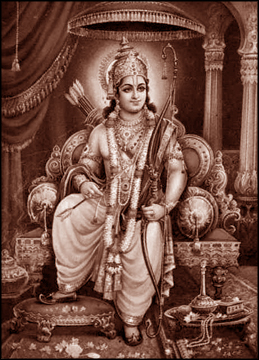Influence of dance and music in Ramayana
By Subashini PATHMANATHAN
In India and Sri Lanka Ramayana evidence could be seen today. For
instance, Sithavaka and Asoka Vana in Sri Lanka, Ramar bridge under
Sethu Samuthra, and Rameshwaram temple in India are some of the
historical evidence which could be seen in both countries.
 |
|
From Ramayana |
Dance and music are an integral part of the life of the people of
India, and Sri Lanka from ancient times. Dance and Music influenced the
life, customs, traditions, and day to day of the two countries. This
influence could be seen and traced from Ramayana. During the Ramayana
period People danced during the time of sorrow and happiness.
Ramayana clearly indicates that a variety of dance forms prevailed
and practised in Sri Lanka and India during those times.
According to the historical evidence, due respect was given to the
dancers and musicians who were called Ganikas. Their artistic skills and
talents were well respected and honoured in society.
In Ramayana the chapters were called Kandas.Most important Kandas
relating to dance and music mentioned in Ramayana were Ayodhyaa Kanda,
Sundra Kanda, and Kiskindha kanda.
Apsaras, the divine dancers of Devaloka, dominated the entire scene
of Ramayana. During the auspicious ceremonies, Raja Abisheka,
coronation, and in royal courts these divine dancers danced. And later
the court dancers were known as Raja Dasis. The court dance teachers
were named as Sailusha.
In Lord Rama's kingdom in Ayodya the roads were referred to as Nataka
Saalai. The words such as Nartaka, Nata, and Ganika could be seen in
Ramayana.Ganika in Ramayana refers to professional musicians and
dancers. The term Nata means the professional actors, and the term
Nartaka denotes the professional dancers.
The term Lasya was used even during those times.Lasya meant the
Nirtha section of dance. During that period there were altogether six
rasas in use. The foot bells were called either Nupara, or kinkini.
Today the same terms are used in dance. Even today the word Laya is in
use. Laya means the balance between the rhythm and tempo. That term was
in use even during the Ramayana period.
A variety of dance forms were in use. Some were based on folk
traditions, and some were based on classical traditions. Whatever it is,
all dance forms were based on Tala, Laya, and Kala (speed variation).The
Tala, and Laya instrument players during the Ramayana period were called
Pannivadaka.
There are some references regarding how the trees, plants, animals
and birds enjoyed the dance and music. This could be seen in the
Kiskindhakanda. Today this is proved scientifically.
In the kingdom of Ravana, music and dance were held in high esteem.
In Ravan's palace permanent court musicians and permanent court dancers
were employed. During those days musician meant not only the vocalists,
but also the instrumental musicians. All of them were held in high
esteem. String instruments like Vipanchi, and Natya Salini were in use,
(these instruments were almost like Veena). Besides these, some names of
the air instruments like the flute were mentioned in the ancient epic.
Even the Queens of Ravana were well versed in dance and music. Bhava and
Rasa were in use in their dances. Even the very technical word such as
Angahara was in use during the Ravana's regime.
Ravana himself was a great musician, and veena player. According to
Ramayana because of his exceptional musical talent, he even influenced
lord Shiva. Ravana was an ardent devotee of Lord Shiva, impressed by his
musical talent, and the Lord presented him a sword named "Chandrahasa".
Even in the epic Rakshasis of his kingdom performed the Goddess
Kali's dances to frighten Sitha, during her imprisonment.
Dance and music were practised and preserved as a part of life of in
the Ramayana era, but these dances may not be in polished forms.
|

